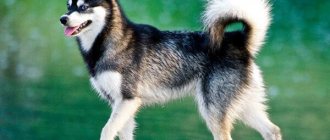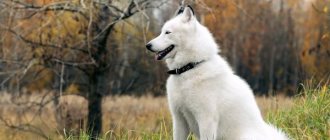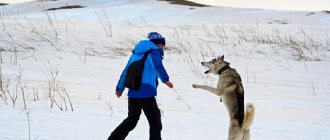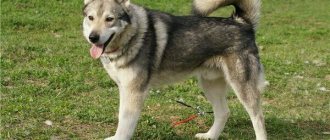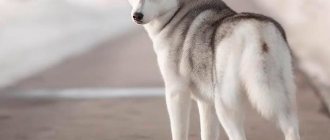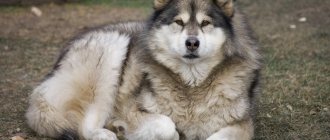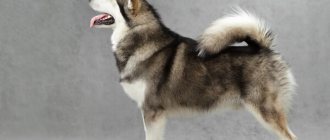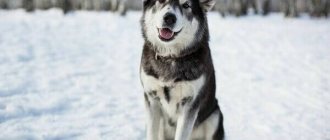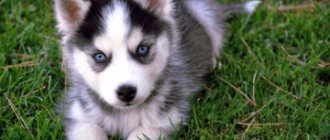Your Siberian Husky puppy has floppy ears because he or she is just a puppy. His or her ear cartilage and bones are not fully developed. Puppy ears are also in the process of growing. You probably just adopted a puppy and are wondering how long it takes for a Siberian Husky's ears to stand up. If your Siberian puppy is less than six weeks old, he most likely has floppy ears. However, each puppy grows at its own pace, and some Siberian Husky puppies may take a little longer. Don't worry, your Husky puppy will develop ears and have erect ears.
When a Husky's ears stand up also depends on his pedigree, physical growth and even diet. If you've adopted a husky puppy, there's a good chance you don't know who the parents are or what the pedigree of your newly adopted puppy is. He or she might as well be a Husky and you will see how he or she will develop. If you are concerned, take your puppy to the vet. At this age, you still send your puppy for veterinary examinations. Your veterinarian will tell you how your puppy is doing and answer any questions you may have. Either way, by the time your puppy is done teething, you will see if his ears stand up.
How and when should a puppy’s ears go up: norm and deviations
All puppies, regardless of breed, are born with small ears pressed to the head. Then the ears straighten and begin to grow. Their size and placement changes.
In breeds with erect and semi-erect ears, the ear cartilage gradually becomes dense and elastic, and the ears begin to rise. The size and shape of the auricle is completely determined by heredity, but the position of the ears is formed during the growth process and is influenced not only by genetic factors, but also by nutrition, since the strength and elasticity of the ear cartilage largely depends on the intake of necessary microelements and vitamins by the body and other substances.
The ears of puppies of breeds with erect ears rise between the ages of 2 and 4-5 months.
Raising ears can take a variety of positions:
- hang in different directions (“helicopter”);
- lean towards each other (“house”);
- take different positions: the puppy holds one ear completely differently than the other;
- the most favorable position is when the tips of the ears are directed forward and gradually rise
- and etc.
The pictures show the main variations in ear position in growing puppies. But others are also possible. All of them are normal, and such puppies may have proper erect ears in the future.
The puppy grows, the head grows, the distance between the ears increases, and the size of the ears themselves increases. At 4 months, a puppy’s ears are already close to the size of an adult dog’s ears. They seem too big for a puppy's head - what is called "to grow."
If the density of the cartilage tissue in the ear is sufficient, then it stands up without problems. If everything goes well, then the angle of the ears both in the “house” and in the “helicopter” and in all other cases will decrease, the tips of the ears will rise, i.e. the ears will straighten and move closer and closer to an upright position (photo 2).
Pay attention to the bending lines of the tilted ear (photos 1 and 2): they should be smooth. The tilt of the ears should gradually decrease, and the ears should straighten.
But if the cartilage in the ear is too soft, then it may not be able to withstand the weight of the enlarged ear, and then the upper part of the ear, instead of straightening, begins to tilt more and more,
That is, at any moment the process can slow down or even be reversed, so much so that even ears that were standing up can fall.
Ears may completely droop when changing baby teeth to permanent ones or after vaccination. Most often, the ears stand up again on their own, even if they fell for a while. But ear drooping is still an unfavorable symptom and evidence that the puppy lacks trace elements (read more: Why ears droop). The right thing to do is to compensate for the lack of microelements that has arisen in the puppy’s diet. If this is not done, and the fallen ear does not rise again after a couple of weeks, then it is necessary to help it (additional feeding + gluing).
So, what points are worth paying attention to:
- If the puppy’s ears lie on his head like soft “rags” and do not even try to rise, then urgent measures must be taken from the age of 3 months. First, you need to slightly strengthen the soft ear cartilage (see Why ears may not stand up). As soon as the ear begins to get stronger, maybe even rise - and this can happen very quickly - you can already evaluate how the ear stands up (see Photos 1 and 2 above).
You should worry about bad ears: for a German shepherd already at 4 months, for small breed dogs - a little earlier. What can and should be done is further in this section.
When the ears begin to rise, you need to follow the curve of the ear. It should be in the shape of an arc, forming a smooth bend. If this line begins to turn from an arc into a corner, urgent help is needed, otherwise a crease that is difficult to fix may form. Gluing and additional feeding are required.
A few more points that are worth paying special attention to: The ear is almost standing up, it just needs to get a little stronger and everything will be fine. But there may also be some pitfalls:
If your ears stand up, be especially careful. We said above that this is the normal way to raise the ears. But, if the ears linger too much in this position, then there is a great danger of a difficult-to-correct crease - at the very base of the ear. And the ear may forever remain rolled inward, as in the photo (photo 3).
There is a situation when an urgent ear gluing is required: the ear has practically risen, but a barely noticeable fold has formed on the auricle (photo 4). A crease or, even worse, a scar may form here. It is important not to miss the moment. Read more: How to recognize the appearance of a crease or scar in the ear in time
If the ears were already raised, and maybe even stood up, but fell during a change of teeth, after vaccination or after an illness and did not rise again after about 2 weeks, then such an ear needs urgent support. The author of these lines believes that a puppy needs additional support as soon as his ears fall off. Why? — Read more: Why ears fall off.
- Most of the ear problems occur due to insufficient strength, i.e. softness of the ear cartilage. It even happens that the ears stand up, but “dangle”, sway when moving. It happens that only the tip of the ear sways or even bends slightly back, forward or to the side. Soft (softish) ear cartilage is corrected not by gluing, but by additional feedings that ensure the formation of full-fledged cartilage (which will help strengthen and position the ears).
Top of page
Emergency measures
Sometimes it happens that all measures are taken, but there is no result. When a husky puppy’s ears do not stand up and all of the above actions are useless, you should move on to extreme measures.
Such measures include gluing. Algorithm of actions:
- Clean your ears with alcohol.
- Trim or shave the fur on the ears.
- Roll the ear cartilage into a tube.
- Seal with a plaster (it is better to use a hypoallergenic one to avoid skin irritation).
- Connect both ears with a bandage.
- After two weeks, remove the structure.
If everything was done correctly, but the ears fell again, after a two-day break you should repeat everything in the same order. It is recommended to carry out the procedure until a stable result is obtained.
You can purchase special inserts at the pharmacy to put your ears in the desired position.
Why ears may not stand up
The age from 2 to 5 months is the most difficult and responsible period in raising a puppy. Almost simultaneously, several intensive processes take place in his body:
These intensive growth processes require not only proteins, fats and carbohydrates, not only vitamins A and D, not only calcium, but also many other vitamins and minerals.
Causes of the problem
When a husky puppy’s ears stand up, the following factors may interfere with the process:
- Heredity (when purchasing a puppy, you need to familiarize yourself with its pedigree, find out whether the dog’s ancestors had ear problems).
- The animal’s well-being (weakened immunity can cause the ears to fall off).
- Diet (the puppy’s diet should contain enough vitamins and microelements for its proper development).
- The degree of activity of the pet (insufficient activity negatively affects the development of bones and cartilage, excessive activity causes overwork, which also has a bad effect on appearance).
- Vaccinations can also negatively affect the condition of a dog's ears.
- Stress.
During the period when the husky's ears stand up, the replacement of milk teeth with molars may begin. At this time, even erect ears can fall and remain in a hanging position for up to six months.
So, what time a husky’s ears stand up depends on various reasons. By eliminating the obstacles that have arisen, you can speed up this process.
What will help strengthen and position your ears?
We said above that the main reason for the insufficient strength of the ear cartilage - and it is precisely because of this that the ears cannot rise - is a deficiency of substances that ensure the formation of strong cartilage. To correct the situation, the deficit must be filled.
We are not talking about calcium at all, as is often written, but about a whole set of microelements: zinc, copper, selenium, silicon, iodine, chromium, vitamins C, D, B2, B6, E, K2, P (flavonoids) and a number other substances that promote the formation of strong collagen and elastin fibers. Anyone who has already read the section Why the “erect” ear does not stand up and how to avoid it can already imagine what role these substances play in the formation of cartilage tissue and why a puppy with problem ears needs them so much.
Everyone can choose supplements containing these components for their puppy, or use any other recommendations. To solve such problems, I successfully use Vision products.
These are “human” supplements of the highest quality (see Production and Quality), have undergone formal clinical trials and have been confirmed to be effective and safe. The preparations are based on herbal ingredients, natural vitamins and minerals obtained from plants. All components are used in veterinary medicine, that is, they are also useful and effective for dogs.
The effectiveness of Vision products in canine science is explained not only by the 100% natural forms of all components, not only by their optimal balance in each product, but also by the fact that, thanks to a special high-tech form of preparation of the components, Vision products are completely absorbed by dogs, even despite their relatively short intestines.
Therefore, Vision's product complexes make it possible to strengthen cartilage and correct ear posture even in situations that are usually considered hopeless.
At the beginning of this section, we looked at situations that deserve special attention. Let's look at what can be done in these cases:
- If at 3 months the puppy’s ears lie in soft “rags” and do not even try to rise: Including a supplement from the children’s line Vision Junior Bee Vice+ or Junior Neo+ in the puppy’s diet will help strengthen the cartilage. For puppies with rich bones (bull terriers, German shepherds, Akitas, etc.), Junior Bee Big will also provide great support. Junior Bee Big is a rich source of plant silicon, and only in this form this vital mineral ensures the full value of collagen and the strength of cartilage and bone tissue, as well as ligaments and tendons. These are very good supplements for healthy puppy growth. They are especially necessary during the period of growth spurt, change of teeth, that is, during a time of INCREASED need for microelements and vitamins.
How much to give? — The prophylactic dosage of Junior Bee Weiss+ or Junior Neo+ is given in the table:
| Adult dog weight | Junior Bee Weiss+ or Junior Neo+: prophylactic dosage for a puppy aged 1.5 to 6 months. |
| up to 2 kg | 1 tablet per week (can be divided into parts and given in parts more often |
| 2 – 5 kg | 1 tablet every other day |
| 5 – 15 kg | 1 tablet per day or 0.5 tablets per day |
| 15 – 30 kg | 2 tablets a day |
| over 30 kg | 2-3 tablets per day |
Prophylactic dosages are used in situations where there is no delay in the formation of the puppy. But they are necessary during the period of active growth, when the need for vitamins and microelements sharply increases, as well as during “natural feeding”.
If the ears are delayed in rising, if the hind limbs of a growing puppy begin to “dangle,” then this indicates a lack of vitamins and microelements for the formation of ear cartilage or strong ligaments. To make up for this deficiency, the dosage of Junior Neo+ or Junior Bee Weiss+ must be increased at least one and a half to two times.
If a puppy eats these “junior” tablets (jelly beans) with incredible greed, preferring them to any “sweets,” then rely on instinct, which is often still retained by small children and, of course, puppies. - Allow the puppy to eat these tablets for some time, at least a few days, in a dosage that is significantly higher than indicated above. — This advice applies only to Vision supplements, because... long-term use has confirmed their safety even with very significant excesses of prophylactic dosages. — I cannot recommend the same regarding additives from other manufacturers, because... it all depends on the composition, dosages and forms of components used, which are unknown to me.
However, the dosage of the products I recommend for a specific dog can be clarified by asking a question to the author of the article (Individual consultation).
— These are tips for cases when at 3 months the puppy’s ears lie like soft “rags” and don’t even try to rise.
If the ears are poorly positioned: - in a German shepherd and other large breeds - at 4 months, - in small breed dogs - at 3 - 3.5 months; if the ears rose but fell; if the ears are erect, but the ear cartilage is soft;
- then it is necessary:
- take care of improving the blood supply to the ear;
- supplement the diet with something that will help strengthen cartilage;
- glue the problem ear.
Recommendations for the first two points are described in great detail in What is needed to form a well-standing ear, and therefore I refer the reader to this page.
If the puppy’s diet is supplemented in time with the supplements indicated in the above section, then usually a month’s course of 3-4 products is enough to improve the ears of a growing puppy. The sooner help for the problematic ear is started, the sooner all problems will be solved. When the body's growth slows down, helping the ear will no longer be so easy.
Proper pet care
Shedding period and fur
To ensure a comfortable stay, you need to literally know everything about huskies, including the features of grooming . It is thick, soft, and has 2 layers: undercoat and main coat. Molting occurs twice a year; it is, of course, more noticeable in an apartment. It lasts about 3 weeks, and you need to comb it out every 2-3 days with a special bristle brush to remove excess undercoat.
At normal times, it is also worth brushing your dog with such a brush to remove dust and dirt. Since Huskies are a noble breed, their coat is very clean and odorless. There is no need to cut the dog's hair.
Ears, eyes, claws, teeth
To keep your pet healthy, you need to follow some hygiene procedures. One of them is ear cleaning; once every 2-3 weeks it is necessary to examine the ears; it is better to have this done by a veterinarian. In order to clean your ears , you need to:
- Take a cotton swab and soak it in a special purchased solution or oil.
- Lay the dog down in a calm state, secure it firmly.
- Massage your pet's ears to make sure he is comfortable.
- Start cleaning your ears gently from the bottom up, doing it very carefully.
After successful cleaning, you should pamper your pet with something tasty to make it easier for him to cope with stress.
The second important element is eye care . To do this, you just need to make sure that there are no purulent discharges, if there are any, carefully remove them with a cotton swab and show the dog to the veterinarian.
Nail care is also important; if the dog is active and walks a lot, then there is no need to trim the nails, since they wear off on the asphalt, but otherwise, you need to contact a veterinarian to sharpen your pet’s claws. You can do this yourself using a special nail clipper, but it is important to remember that you only need to trim a few millimeters so as not to damage the blood canal, which will be very painful for the dog.
It is especially important to monitor the health of your Husky's teeth. To do this, you need to clean it once a week using special products that can be purchased at the pharmacy (brush, paste, nozzle).
In the same group (No. 5 - Spitz) with Husky there are such breeds as Pomeranian Spitz, Akita Inu, Samoyed, and Chow Chow.
Bathing
Huskies should be bathed no more than once a year , using special shampoo and cool water. If the dog lives in an apartment, then shampoo for washing paws should be used extremely rarely, as this harms the husky’s skin.
How long should you walk your husky?
Since Huskies are a very active breed, a daily walk should be 4-5 hours! If you are not willing to devote that much time to this, it is worth finding another breed, as Huskies are very active. In this case, half the time should be spent on active training, games or running, as the dog needs to release all its energy.
How to determine whether you need to glue your ears
If one or both ears of a puppy do not stand up well, fall out or in, or dangle when moving, it is important to determine whether the ear needs gluing or whether it can rise without outside help.
If the ear falls at the very base (as in photos 3 or 5), then gluing is definitely necessary. The ear should be straightened and glued at the very base so as to get rid of the collapse. The seal should ensure the vertical position of the ear.
Gluing is also required for a crease, either already formed or just emerging (see How to recognize the appearance of a crease or scar in the ear in time). It is especially important here when gluing to carefully straighten the crease or scar.
If there is no crease, but the ear does not stand up and bends, then you can determine whether there are weak spots in the ear that prevent the ear from rising.
To do this, use the tips of two fingers (thumb and index) to feel the auricle. Pinching the ear from the inside and outside with the tips of two fingers, determine the weak point. This is either a small “spot” or a stripe. It is enough to hold this spot between two fingers to strengthen it (while you hold it). You will see the ear stand up.
If this spot is in the upper third of the ear, then gluing is not needed. - In any case, if the puppy receives the necessary Vision supplements to strengthen the cartilage. On Vision products, the ear will rise and strengthen itself in such a situation. If this is not a spot, but a strip across the entire ear and this strip is almost devoid of cartilage, then a crease has formed, and gluing is required.
If the weak spot is in the middle of the auricle, in the lower third or at the base of the ear, gluing is necessary.
For detailed instructions on how to glue an ear, see How to glue ears. If the ear cartilage is very soft and does not stand up under any circumstances, then you first need to help strengthen the cartilage, and then move on to gluing.
Photo 5. The ear on the left has little chance of standing up on its own. This is where gluing is necessary.
Most of the ear problems occur due to insufficient strength, i.e. softness of the ear cartilage.
Soft (softish) ear cartilage is not corrected by gluing; ear strengthening is provided by additional feedings that ensure the formation of full-fledged cartilage (which will help strengthen and position the ears).
Life in the Far North dictates strict rules of survival for a person. For the nomadic life of the indigenous population - the Chukchi, when moving from one camp to another, a strong, hardy sled dog was needed. – which is capable of not only courageously overcoming the climatic conditions of the “living” space, but also covering tens of kilometers in harness in low-temperature conditions. It was these qualities that the husky dog breed possessed - an irreplaceable friend and faithful comrade of the Chukchi. Not a single camp is complete without Siberian Husky dogs - intelligent, affectionate, unusually graceful, with a special sense of tact and dignity, very friendly towards people. To pull a loaded team - this is the instinct inherent in the sled dog breed, and they run easily, with obvious pleasure! The leader pulls the team at a stable speed of 14-18 km/h.
The Siberian Husky breed has the following characteristics:
The height (height) of a male dog at the withers is 54-60 cm. Weight is from 16 to 27 kg. Bitches are slightly inferior to males in height and weight.
The head is small, rounded, tapering from the eyes to the nose;
The eyes are almond-shaped, slanted, brown or light; huskies are especially valued for their extraordinary blue eyes. Thanks to the piercing, wise look of the husky dog, the impression of deep, “human” contact with the animal is created. The expression on a dog's face is always positive, mischievous, and meaningful. The Siberian Husky dog always feels the state of the owner and can share both sadness and joy with him;
The ears are neat, triangular in shape, set high and relatively close to each other, covered with thick hair;
Neck – small, strong;
The back is straight and strong, perfectly adapted for riding in a harness;
Teeth – large, even, bite – scissor-shaped;
The abdomen is retracted, with a deep chest;
Tail – fluffy, drooping downwards
Wool – with a thick undercoat, forms a luxurious coat on the Husky dog. The color of the coat varies from black to white. It is unusually soft, thick, pleasant to the touch. Color “stains” of various patterns on the head are allowed.
Paws – long and wide, with powerful limbs;
is smell .
In a litter, a female Siberian Husky brings from 4 to 6 puppies. Husky puppies feed on their mother's milk for up to one and a half months, and then they are ready to switch to a meat diet. A husky dog's eyes open 14-16 days after birth. The price for husky puppies is quite high - 15,000 rubles; an adult husky can cost about 30,000 rubles and more.
Breed Features
Huskies are luxurious and well-built animals. They are distinguished by special restraint and self-esteem. But this does not mean at all that dogs do not like to frolic and play with their brothers. By the way, they will not leave their owners unattended, even on walks. After all, huskies are very attached to “their” people. This is how it happened historically. In ancient times, animals warmed people and their small children with their warmth on cold evenings and nights. Therefore, huskies are excellent, caring nannies and will be able to find contact with any child.
But a dog of this color is unlikely to be suitable for hunting. Of course, the hunting instinct of these pets is enviable. But, having caught game, do not expect the dog to bring it to you. Most likely, she will dine on the prey herself.
As for external characteristics, huskies are medium-sized dogs, with thick hair and dense undercoat. A distinctive feature of this suit is a special mask on the face and a non-standard eye color, most often bright blue or brown. But the most popular lucky dogs are considered to be harlequins (dogs with multi-colored eyes).
In addition, animals have a tail curled into a ring in the active state, which can be lowered in rest mode. As for the ears, they are completely erect. Creases and bends are considered defects or deviations associated with a lack of nutrients in the body.
The healing properties of dog hair
One of the global directions of our workshop is handmade yarn from dog hair and knitted medicinal products from it. I will tell you the uniqueness and healing properties of dog hair in this post.
Let me immediately emphasize that there is an incredible amount of information on the Internet about the healing properties of hair in general, and especially dog hair. Therefore, I will only talk about the wool of Siberian Huskies - the wool that we use.
A little information about the wool itself:
1) One of the important advantages of Siberian Husky wool is the absence of odor and hypoallergenicity
2) Husky wool is water-repellent. Dogs can sleep in the snow or in the rain - water practically does not penetrate under their coat. Thanks to this quality, human skin does not sweat under clothes and products knitted from the wool of this dog breed
At what age do husky ears stand up?
According to the breed standard, a Husky puppy's ears should be erect. But not all representatives can boast of such an achievement at an early age. After all, puppies of any breed are born with drooping ears, which rise as they grow and mature.
Many dogs of small decorative breeds have their ears glued in order to quickly achieve the desired result. But, if husky puppies have drooping ears , then do not rush to resort to this method. Most likely, the baby is still too small and his body is not strong enough. After all, for such a seemingly simple process, a large supply of calcium is required, which, by the way, is recommended to be replenished with the help of vitamins during the period of active growth.
Huskies are a strong breed. And, therefore, as a rule, such husky babies’ ears stand up quite early. The development process is quick and by the time of purchase, the puppy already has clearly defined, erect ears.
Story
Laika is one of the oldest dog breeds. Initially, it was bred by residents of the North, including the Tungus. By crossing with other dogs, representatives of the breed deprived their offspring of the valuable qualities inherent in the husky. To preserve the purity of the breed, northern hunters shot all alien dogs without regret.
Intensive breeding of huskies began in the nineteenth century. Then the husky was called the northern pointy-eared dog. At this time, breed standards were clearly described, and the behavioral characteristics of these dogs during hunting were studied. In 1928, for the first time in Russia, an exhibition was organized where various varieties of huskies were presented.
During the war, huskies were used for transporting goods, as well as for blowing up objects and searching for mines, which reduced the number of representatives of this breed. In order to rectify the situation at the end of the war, dog kennels were created, in particular those that exclusively housed huskies. Intensive breeding of these dogs has provoked the need to establish new breed standards.
Today we have many types of husky breeds. They all differ from other dogs in a common set of character traits.
How many months does a husky puppy's ears stand up?
What time do husky ears stand up ? A question that interests many novice dog breeders. The formation of ears is an individual process. Some owners can boast of this result already at one and a half months of age, and some huskies do not have ears even at six months. There's no need to panic. It is important to monitor the quality of food and add vitamin supplements to the diet to provide your pet’s body with everything it needs. After all, sometimes the main problem why husky puppies have drooping ears lies precisely in the lack of calcium and other useful “building” substances.
Also, it is important to note that during the period of teeth change, that is, at about six months, a new problem may appear - the husky puppy’s ears have fallen off. But there is no need to run to the veterinarian for an examination. Again, vitamin complexes and time will help you and your pet. As soon as the change of teeth is completed, the ears will take their usual position.
Main characteristics
- balanced proportions;
- the average size;
- free and easy movements;
- neat head shape;
- moderate backbone (skeleton);
- appropriate length and condition of the coat;
- tail of correct length and feathering;
- friendly character.
Similar articles:
- Keeping a Siberian Husky in an apartment or private house
- Character of the Siberian Husky
- Why do huskies have different eyes?
- Siberian Husky colors
- Longhaired Husky
Radical methods
If at two, three, or even eight months your pet cannot boast of straight ears, then there is a significant problem. Only an experienced veterinarian can identify it. As a rule, it lies in the pet not being purebred or in poor quality nutrition or lack of vitamins. The last reason can be solved quite simply and quickly by adjusting your diet and taking vitamins.
If the reason is that the dog is not purebred, you can accept the pet as it is, or try to add ears. There are several methods:
- glue it yourself, using cotton swabs and patches;
- contact a veterinary clinic for gluing;
- surgical intervention. By the way, this is the most extreme and emergency way out of the situation. Think carefully before putting your pet under the knife whether erect ears are worth the stress the animal will experience.
The exterior of a pet is an important indicator that allows you not only to proudly walk the streets with your dog, but also to participate in various exhibitions and competitions. This is why many people worry about at what age do Husky ears stand up and what to do if they are still drooping. We hope this article was useful and helped you understand this issue.
Movements
The Siberian Husky is characterized by smooth, easy movements without noticeable effort. At exhibitions, the dog's gait is taken into account, namely, a good extension of the front limbs, a good push of the hind limbs. To demonstrate the movements, the dog is led out on a loose leash and the dog must move at a moderately fast trot. While running, the back line remains clear and even.
Disadvantage: movement with short steps (mincing gait), skipping, limping gait, movement with crossing or divergence of limbs.

